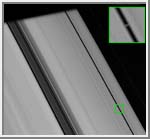
Pan, the innermost known satellite, was found from photographs taken by Voyager during its encounter with Saturn. It was discovered by Mark R. Showalter in 1990, 9 years after the Voyager encounter. Pan is located 133,583 kilometers from the center of Saturn and is within the Encke Gap of Saturn's A-ring. It acts as a shepherd and is responsible for keeping the Encke gap open. It has a diameter of 20 kilometers.
| Pan Statistics | |
|---|---|
| Discovered by | Mark R. Showalter |
| Date of discovery | 1990 |
| Mass (kg) | ? |
| Equatorial radius (km) | 9.655 |
| Equatorial radius (Earth = 1) | 1.5138e-03 |
| Mean density (gm/cm^3) | ? |
| Mean distance from Saturn (km) | 133,583 |
| Rotational period (days) | ? |
| Orbital period (days) | 0.5750 |
| Mean orbital velocity (km/sec) | 16.90 |
| Orbital eccentricity | 0.00 |
| Orbital inclination (degrees) | 0.0 |
| Visual geometric albedo | 0.5 |
| Magnitude (Vo) | ? |
 Pan
Pan
This image shows the small moolet Pan located within the Saturn's
Encke gap. The contrast has been enhanced and the image has
been sharpened.
(Copyright © 1998 by Calvin J. Hamilton)
 Pan Within Encke Gap
Pan Within Encke Gap
This is the highest resolution image of Pan from the Voyager data.
This image shows the A ring entering Saturn's shadow. Pan is
located in the center of the small box within the Encke gap.
Pan is shown enlarged and enhanced in the inset box.
(Copyright © 1998 by Calvin J. Hamilton)
Showalter, Mark R., "Visual detection of 1981S13, Saturn's eighteenth satellite, and its role in the Encke gap," Nature, Vol. 351, 27 June 1991, 709-713.

 Saturn
Saturn Atlas
Atlas